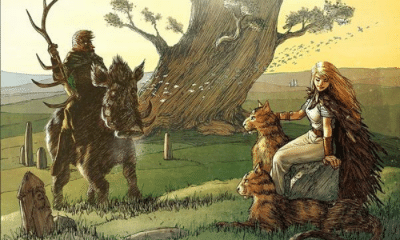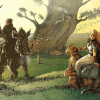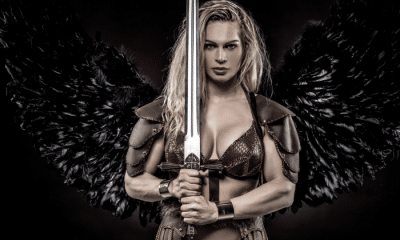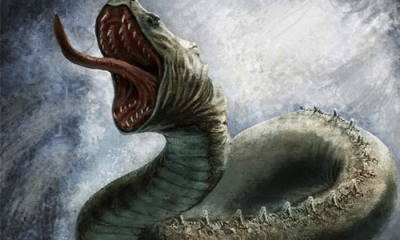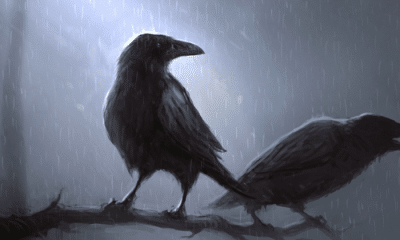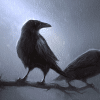Freya: The Norse Goddess of Beauty and Magic
Freya is usually called the goddess of beauty in Norse mythology, but her full role is much more complex than that. Keep reading to learn all of Freya’s secrets and how well she kept them!
Freya, spelled in Old Norse as Freyja, was a beautiful and alluring goddess in Norse mythology. Associated with fertility and femininity, later writers sometimes portrayed her as a type of femme fatale or immoral harlot.
The Norse people, however, saw Freya in a much different light. While her beauty was treasured, it was not the most important aspect of her role.
Freya was a goddess of magic and fate. Her knowledge was at least equal to that of Odin, but she never revealed her secrets or tried to change events she knew were inevitable.
Her power over fate also made her Odin’s rival as a host of the dead. While Valhalla is the famous afterlife of Viking warriors, Freya’s home actually received a better selection of honored fighters.
While many myths highlight Freya’s desirability and beauty, she was a much more complex member of the pantheon than you might first expect.
Freya and the Vanir Gods
The early myths of the Norse gods describe them as belonging to two distinct pantheons. The Aesir as usually thought of as more war-like, while the Vanir were depicted as gods of fertility and wisdom.
Freya was born among the Vanir gods. Her father was their leader, Njord.
She also had a twin brother. Freya and Freyr were often paired together in their images and myths.
The Aesir and Vanir went to war with one another. The conflict is not detailed in surviving myths, but its aftermath is well-attested.
Although the Aesir were warriors, the Vanir did significant damage to Asgard. It is often believed that they used their knowledge of magic in place of strength of arms.
The war reached a stalemate. With both sides having suffered damaging losses, the two groups convened to discuss the possibility of brokering peace.
As part of the truce, the two groups of gods exchanged members. Njord, the wealthiest of the Vanir, moved to Asgard and was adopted into the Aesir.
Although they were not named as part of the exchange, Freya and Freyr joined him as well. Although they were still gods of the Vanir, their choice to join their father made them honorary members of the Aesir pantheon as well.
While the Aesir and Vanir were supposedly made equal in the agreement, the Aesir are much more prominent in mythology. Although evidence exists that the Vanir may have been widely revered, poets chose to highlight the Aesir gods in their stories.
Freya and her family members are the only Vanir gods to play significant roles in the surviving Norse myths.
Many scholars believe that the story of the Aesir and Vanir gods reflects the merging of two different religions in the Norse past. The Aesir are largely based on Germanic archetypes while the Vanir gods appear to be entirely native to the region.
It is largely supposed that both traditions influenced later Norse mythology, but the most dominant gods were those of the Germanic Norse. Odin and his kin took a position of supremacy over the native Vanir pantheon.
Freya and her family were adopted into the Aesir in the story because, in reality, they were the local gods most widely accepted by the Germanic people. They were added into the pantheon as native Scandinavian gods who were both accepted by and separate from the dominant Germanic traditions.
Some of the differences can be seen in the domains of the Vanir and their specific powers. According to many legends, it was the Vanir who taught the Norse gods how to do magic.
The Goddess of Magic
More than one type of magic existed in the Norse worldview. Seidr is the type mentioned most often in the surviving myths.
Seidr was a type of magic that centered around fate. Simple spells and potions could change fate in minor ways, such as causing a person to fall in love or sleep through an important event.
More powerful practitioners of seidr could use their magic to truly understand and influence the workings of fate. Entering a trance-like state, they could peer between realms to see the complex web of threads that represented the events of each person’s life.
These magic users could interpret these threads to make prophecies about the future or learn truths about the past. A few were even powerful enough to slightly move the threads to make minor changes to fate.
Freya was considered to be a master of these magical arts. It was said that the Aesir had no knowledge of seidr until Freya joined them and began to teach her skills.
Odin quickly adopted this new magic and became an accomplished seidr user. Many of his myths highlight his search for new magical knowledge such as the secrets of the runes or forgotten incantations.
Some claimed, however, that Freya’s power was still stronger than Odin’s. Although he became exceptionally powerful, his skill never quite matched Freya’s own.
Odin also had to make great sacrifices to learn his art. Freya seemed to come by her powers naturally.
Even the gods, however, had little knowledge of the depths of Freya’s abilities. Unlike Odin, she rarely shared what she knew.
Many scholars consider it possible that Freya had more knowledge of many of the foretold events in mythology than Odin did. She demonstrated more wisdom by keeping what she knew a secret.
Many myths center on the gods’ attempts to change fate and avoid Ragnarok. They tried, for example, to prevent Balder’s death first by making him immune from harm then, when that actually led to his death, by bringing him back from the realm of Hel.
As a natural user of seidr, however, Freya would have understood that such a fate was unavoidable. Telling the other gods what she knew would only hasten the inevitable as they tried to change destiny.
Freya and War
Freya was associated with fate in more than just her magical knowledge, however. She was also a figure in the realm of death.
The Norse afterlife was not generally based on a person’s virtue or faith. Instead, the manner in which a person died determined where they went in death.
Most people went to Hel, the realm ruled by Loki’s skeletal daughter of the same name. This was a cold and bleak place.
Those who died in battle, however, earned a better version of the next life. They joined the gods in Asgard.
Odin’s hall, Valhalla, is the most famous afterlife realm of Norse mythology. Several sources detail its endless feasts, constant fights, and the scale of its grandeur.
Freya, however, also had a role in hosting the honored dead. In fact, some myths specify that she chose her warriors even before Odin chose his.
The ninth is Folkvangr, where Freyja decrees
Who shall have seats in the hall;
The half of the dead each day does she choose,
And half does Odin have.
-Poetic Edda, Grimnismal (trans. Bellows)
This poem implies that Freya gets the first choice of those who died in battle. Odin’s warriors at Valhalla were, in fact, those left over after Freya chose the best.
Her presence on the battlefield has led many to interpret Freya as the leader of the Valkyries, the group of goddesses who carried fallen warriors to Asgard.
The Valkyries are usually shown in service to Odin, but others have interpreted them as being followers of Freya. As the goddess of the battlefield, it would make sense for her to command the more minor goddesses serving under her.
While the Valkyries are given names in some sources, others say they are too varied and numerous to name them all. Most importantly, they also say that the Valkyries were not born in that role.
Aesir and Vanir goddesses, jotnar (giantesses), and elves are all named as Valkyries.
In many mythologies, such a collection of minor goddesses would have a more prominent deity at their head. The Greek nymphs, for example, were often followers of Artemis or Dionysus.
Freya’s prominence on the battlefield has led many to believe that she served a similar role as the commander of the Valkyries. Because she got the first pick of the warriors, she would be the one to give the minor goddesses their orders.
The role emphasizes Freya’s position as a goddess of fate and magic. Knowing each man’s fate, she would be able to foretell how each would darwin battle.
This knowledge would give her a similar position as that of the Morrigan in Irish mythology. As with her knowledge of Ragnarok, however, Freya differed in that she never disclosed the extent of her foresight.
Some later stories reimagined the role of Folkvangr, Freya’s home in Asgard. Rather than being the place the most honored warriors went, it was thought of as a place where those who died well but outside of battle went.
While Hel remained for those with inglorious deaths, Folkvangr became the destination for those who did not fight. Women who died in childbirth or those who died for an honorable cause, for example, were welcomed by Freya.
This view was popular, but likely foreign to the Norse people. It was almost certainly a later development based on similar views from other European cultures.
The Goddess’s Prized Items
Some of Freya’s myths center around her most prized possessions.
Items were important in Norse and Germanic legends. Swords, instruments, jewelry, and even pots were given names if they were of particular importance.
Many of these were not only well-made and beautiful; they were also imbued with powerful magic.
Freya owned several such items which played a prominent role in some of her stories. These included:
- The Falcon Cloak: Freya’s feathered cloak gave the power of flight to whoever wore it. While she used it, she also lent it to Thor and others when they needed to love quickly.
- Brisingamen: Her gold torc, a neckband symbolizing power and wealth, was arguably Freya’s most valued possession. Some myths claimed that it enhanced the wearer’s beauty and Freya guarded it jealously against possible thieves.
- Hildisvini: Both Freya and her brother were associated with swine. Her pig was a close companion. In one story, she transformed a man into Hildisvini so she could take him to see a prophetess without anyone knowing.
- The Cat Chariot: Many gods had unique steeds. Freya’s chariot was pulled by two black or gray cats, animals often associated with magic.
Brisingamen is Freya’s most famous possession, but the story of its creation is a later one.
Written in the 14th century, the legend claimed that Freya was Odin’s consort. While visiting four dwarves in their workshop, she spotted the lustrous neckband and begged to have it.
The wily dwarves said that Freya could only claim the torc if she spent the night with all of them. She did so without hesitation and returned home as if nothing had happened.
Loki eventually learned of Freya’s actions and informed Odin what had happened. The jealous god stole the necklace and would only return it if Freya made two kings fight an endless war.
Scholars dismiss this popular story, however, as a later invention meant to discredit the pagan goddess.
The story was written by Christian priests who highlighted Freya’s perceived immorality to turn people away from the old pagan gods. The story of Freya’s lust was unknown in earlier Norse sources.
The priests who wrote it, however, did not entirely invent the story.
As a goddess associated with love and fertility, Freya’s mythology was at odds with medieval Christian views of morality and propriety. While none of her actual myths were as scandalous as that of Brisingamen, they were still salacious enough to demonize her in the eyes of medieval priests.
Freya’s Avoided Marriages
While some of Freya’s stories involved love affairs, many more told of how she avoided unwanted marriages.
In one famous story, the question of Freya’s marriage came up when the gods sought to rebuild Asgard’s walls after the Aesir-Vanir War.
A builder offered to do the work by himself, with only a horse to help him. What’s more, he guaranteed that he could complete the job in a year’s time.
The price he asked was Freya’s hand in marriage. While the gods balked at the offer, Loki convinced them to reconsider.
The task would be impossible, he reasoned, bt the builder would still complete a year’s worth of work. Freya was at no risk but the gods could get a good amount of work done for free.
When the builder began the project, however, it was clear that he was no ordinary mason. He was actually a hill giant whose immense strength allowed him to tirelessly do the work of several men.
With the work nearly completed, the gods commanded Looki to save Freya from marrying a giant because of his scheme. He ended up taking the form of a mare to lure away the giant’s horse.
The hill giant completed all but a few stones in the wall’s construction. Freya was spared and Asgard’s walls built at no cost, but Loki ended up giving birth to Sleipnir while still in the form of a female horse.
In another story, a giant named Thrym stole Mjollnir, Thor’s famous hammer. He demanded Freya in exchange for the powerful weapon.
Freya would not concede to such an arrangement, but the gods could not allow an enemy to possibly use such a great tool against them. Once again, a plan had to be devised to save Freya from the fate of marrying a giant.
Heimdall suggested that Thor disguise himself as Freya to steal Mjollnir back. He would be welcomed into Thrym’shall and be able to take his hammer at the first opportunity.
Thor was against the idea, but Loki offered to accompany him as a maid. Disguising themselves as women was preferable to Freya being sold to a giant.
Thor and Loki went to Thrym’s hall disguised as women. They wore heavy veils to hide their bearded faces.
Thrym welcomed them, but soon ad doubts. He grew suspicious when the veiled goddess ate several whole animals and drained three casks of mead at the wedding feast.
Loki told him that Freya had been so nervous that she had not eaten for several days. Her hunger was a result of her fast.
When the giant saw Thor’s eyes glaring at him, Loki again explained it away by saying that Freya had not been able to sleep, either. The intense glare was due to exhaustion, not fury.
Finally, the feast ended and Thrym ordered the hammer to be brought out to sanctify the marriage. As soon as it was within reach, Thor grabbed Mjollnir and killed all the giants who had come to the feast, including Thrym.
Freya did eventually marry, however. Her marriage was to a god named Odr, although the union has been interpreted in many ways.
A Possible Dual Role
Freya’s husband, Odr, is rarely attested in other myths. He is not named in lists of gods, mentioned in the events of Ragnarok, or given a detailed family history.
In fact, Odr seems to have little meaning beyond his role as Freya’s spouse.
Some historians have seen both the mysterious god’s name and his union to Freya as possible evidence for duality in Norse mythology.
Odr, they believe, is another name for Odin.
Odin, however, was married to Frigg. While he had other mistresses, Freya is not named as one of them.
Scholars believe that Odr’s identity does not imply infidelity on Odin’s part, but the possibility of Freya herself serving as part of a dual goddess.
Freya, they believe, may have been so closely associated with Frigg that they were seen as versions of the same goddess.
Odin’s wife is traditionally thought of as a goddess of family, marriage, and motherhood. She fits into the common role of the maternal queen goddess.
Frigg comes from a well-known archetype. She can be linked linguistically and thematically to goddesses of other Germanic cultures.
Freya, on the other hand, is not seen outside of Scandinavia. Where she has some similarities to other goddesses, she does not belong to the same kind of strong archetypal tradition as Frigg.
The two share some similarities between one other, however. Both are associated with fertility.
They also have strong links to Odin. While Frigg is named as his wife, Freya shares his domains of magic and warfare.
Some historians believe that Frigg and Freya were at least partially syncretized. While they began as entirely separate goddesses, their overlapping roles led to them being seen as two aspects of the same type of divine power.
Odr, according to this interpretation, is an aspect of Odin that better fits Freya as a husband.
While Frigg was a maternal aspect of the goddess that fit Odin’s role as the All-Father, Freya complemented his role in war and magic. Odr was the magical side of Odin that was paired with Freya in her role as a seidr shamaness.
This idea is not universally accepted, however. Many historians do not see enough evidence to support the theory that Frigg and Freya were two aspects of the same goddess even if they do believe Odr may have been an alternative name for Odin.
Beyond Freya’s Beauty
Freya was a Vanir goddess who was adopted, along with her father Njord and twin brother Freyr, into the Aesir pantheon.
Like most Vanir deities, Freya was associated with fertility. She was renowned for her beauty and femininity.
Many myths centered on Freya’s desirability. At least two stories told of attempts by giants to force Freya to marry them, both of which were foiled by Loki’s schemes.
Later Christian writers used these stories to discredit and demonize the goddess by highlighting perceived immorality. While their stories were later inventions, they remain in the popular imagination.
Norse beliefs regarding Freya were far more involved than her beauty, however.
As a Vanir goddess, she was a master of seidr magic. She was said to have introduced knowledge of fate, healing, and spellcraft to the Aesir.
Freya’s knowledge was only rivalled by that of Odin but, likely because she recognized the impossibility of preventing Ragnarok, she rarely


